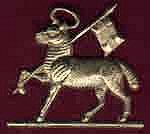Ashtead War Memorials - WWI
Pte George Ernest Taylor
8th Bn, The Queen's (Royal W Surrey Regt)

GE Taylor appears to have been a grandson of Richard Taylor [born ca 1837 in Leatherhead], Baker, and his wife Esther née Hill [born Bookham ca 1840] whose marriage was registered at Epsom, June Quarter1860. The arrival of their first-born son, Ernest, was registered again in Epsom, but for December Quarter1864, and by 1881 the family were established as residents of Ashtead.
In the Summer of 1891[registered Kensington] Ernest Taylor married Frances (Fanny) Elizabeth Bligh [born ca 1864 at Swaffham, Norfolk], a General Servant. The 1901 Census enumerates this family in Agates Lane, Ashtead between The Laurels and Murreys Court inhabiting what a later record describes as Murreys Court Cottage.
Ernest was employed as a Coachman (presumably by Mr CM Robertson) and, amongst his four children may be found the subject of the present article, George E Taylor, aged 4, born Ashtead, Surrey, although, confusingly, he appears in Epsom’s register 12/1896, as Ernest George.
George E Taylor had moved away to Guildford but returned to Ashstead [sic] to volunteer for military Service after the outbreak of WWI. He was accepted into 8th (Service) Battalion, The Queens (Royal West Surrey Regiment) which had been formed at Guildford in September 1914 as part of “Kitchener 3” and was attached to 72nd Brigade, 24th Division.
One is introduced to that Division on http://www.longlongtrail.co.uk/army/order-of-battle-of-divisions/24th-division/
The Division moved 19-23 June 1915 to Aldershot for final training. Lord Kitchener inspected the Division at Chobham ranges on 19 August and next day it was the turn of King George V. Orders were received on 19 August to move to France and the first units departed one week later.
Concentration was completed in the area between Etaples and St Pol on 4 September. The Division's first experience was truly appalling. Having been in France for only a few days, lengthy forced marches brought it into the reserve for the British assault at Loos. GHQ planning left it too far behind to be a useful reinforcement on the first day, but it was sent into action on 26 September, whereupon it suffered over 4178 casualties for very little gain.
The Division served on the Western Front for the remainder of the war, taking part in many of the significant actions.
George Taylor was not, however, drafted to France until 22 December 1915 consequently avoiding the Battle of Loos but arriving in time to experience the German gas-attack at Wulverghem. War Diaries for 8th Bn., The Queens, refer to the disposition of D Company during January 1916 when the Battalion’s HQ was sited at Zouave Wood.
An entry for 5-7 February 1916 reads: - “Fine clear days and Ypres was heavily shelled throughout morning and afternoon. We suffered 5 casualties, one of whom was killed.”
Although this laconic record does not identify either the dead man or wounded soldiers, one may infer that George Taylor had been amongst the latter who would have been evacuated to the Allied main base at the rear, Lijssenthoek, where Casualty Clearing Stations were situated. He appears to have died there from his wounds before being interred in the Military Cemetery, 5 February 1916.
A History of Ashtead mentions that memorial services for those killed in action included one for George on 27 February 1916
text: Brian Bouchard: if you can add to this page please contact
the editor
page added 9 Mar 2009: 28 Nov 17